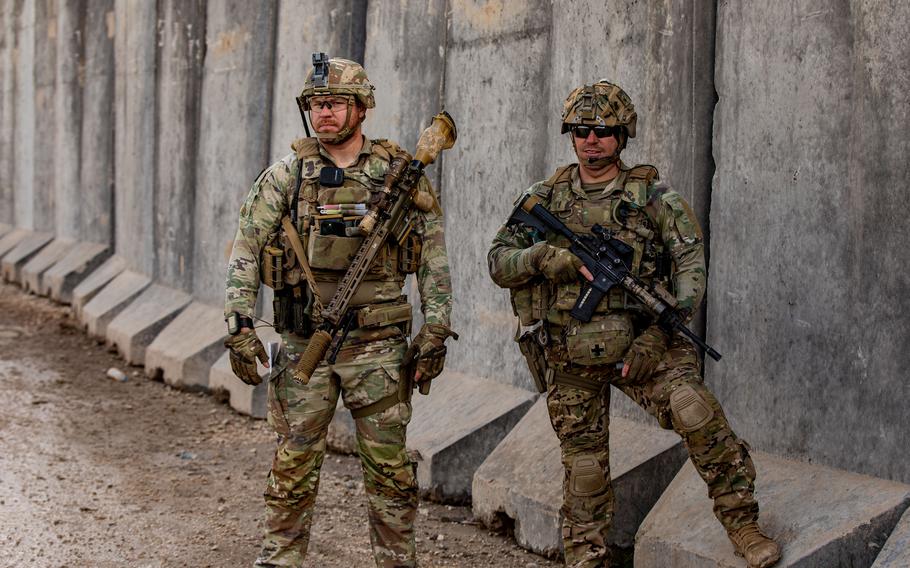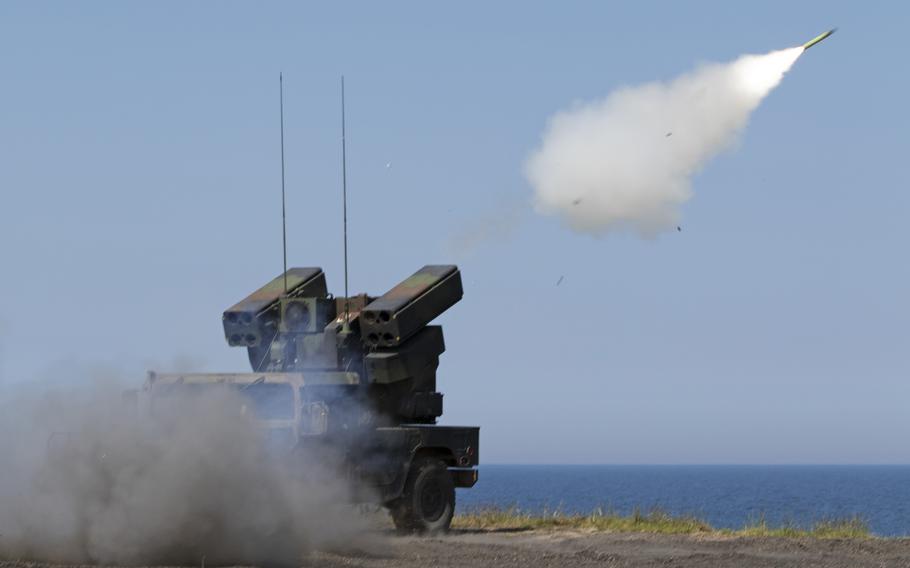
Army Sgt. Robert Russell and Staff Sgt. Dexter Robertson prepare for a patrol in Syria on Feb. 3, 2023. Military investigators are looking into how an aerial drone evaded defense systems in a March 23 attack that killed an American contractor and wounded five service members as well as another contractor at a base in Syria, U.S. officials said. (Julio Hernandez/U.S. Army)
A little-known Islamic militia’s claims of responsibility for a deadly drone attack last week on a U.S. base in Syria have experts casting suspicion on Iran, which a number of them consider the real perpetrator.
In a message posted Sunday on a Telegram channel claimed to be run by Islamic Resistance Liwa al-Ghaliboun, the militant group said it had launched a one-way drone March 23 that killed an American contractor and wounded five service members as well as another contractor.
But Liwa al-Ghaliboun most likely does not exist, analysts interviewed by Stars and Stripes said, an assessment that echoes U.S. military leaders’ pronouncements.
“The militia that claimed responsibility for this is the most obvious example of ‘it’s just a front,’” said Charles Lister, a senior fellow at the Middle East Institute, a Washington-based think tank.
The U.S. said the attack came from a group affiliated with Iran’s Islamic Revolutionary Guard Corps, which backs militias throughout the region and hopes to drive U.S. troops out of Iraq and Syria.
“An attack like this doesn’t happen without official IRGC know-how,” Lister said, adding that all of Liwa al-Ghaliboun’s claimed attacks in the past have been against high-profile targets.
A video released by Liwa al-Ghaliboun after the attack shows the launch of a one-way aerial drone similar to those used by Iranian-backed militias in Yemen, said Jeremy Binnie, an analyst at the defense intelligence firm Janes, who said he too believes that the group is a front.
The logo in the group’s letterhead is almost the same as that of Kata’ib Hezbollah, a militia known to be backed by Iran, analysts said.

An Avenger missile system fires a stinger missile during an exercise in Utska, Poland, in 2019. The main radar for an Avenger system at a U.S. base in Syria was reportedly not working March 23, 2023, when a drone struck a maintenance facility at the base, killing an American contractor and wounding five service members and another contractor. (Joanna Gaona Gomez/U.S. Army)
The U.S. sees some discrepancies in who is believed to have launched the attacks and who’s claiming responsibility, an American official close to the operations but unauthorized to speak on the record said this week.
American military leaders have long complained about Iran’s use of groups with ever-changing names to make attribution for attacks more difficult.
The use of cutouts gives Iran and its affiliated militias plausible deniability, said Jonathan Lord, a senior fellow at the Center for a New American Security, a Washington-based think tank.
Last week’s attack is one of 83 launched by Iranian-backed militias against U.S. troops in Syria since January 2021, Defense Secretary Lloyd Austin told Congress this week.
The U.S. has about 900 service members in Syria, part of joint efforts with Kurdish fighters to prevent the resurgence of the Islamic State, according to U.S. Central Command.
The U.S. also has about 170 contractors in Syria, CENTCOM spokesman Lt. Col. Dave Eastburn said last week.
Meanwhile, an ongoing investigation by the military aims to determine how the drone made it through to the target.
A Pentagon official told The New York Times on Monday that the main radar for the Avenger missile defense system at the base near Hasakah was not operating when the attack happened because it had maintenance problems.
The official added that a backup radar didn’t detect the drone, either, the newspaper reported.
And on Capitol Hill, some lawmakers questioned whether the Pentagon has been forthcoming with details of the attack, which prompted a round of U.S. airstrikes and militant group counterstrikes.
U.S. Sen. Tom Cotton, an Arkansas Republican and former Army officer, said Tuesday that Congress hadn’t gotten the full story from DOD.
The attack occurred in the morning Eastern time and lawmakers weren’t alerted until late at night.
During the 13-hour gap between the attack and the announcement, CENTCOM commander Gen. Michael Kurilla testified before Congress about the status of U.S. forces in the Middle East.
Kurilla did not mention the Syria attack during his congressional testimony. His spokesman later told Politico that the general didn’t want to discuss it during the hearing because the families of the wounded were still being notified.
Austin conceded that the Biden administration should have notified Congress about the attack earlier, Politico reported Tuesday.
In total, 13 personnel were injured in attacks on March 23-24, Air Force Brig. Gen. Pat Ryder, a Pentagon spokesman, told reporters Thursday.